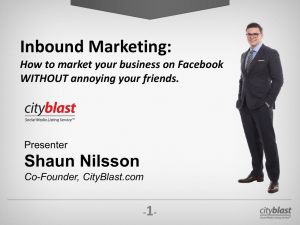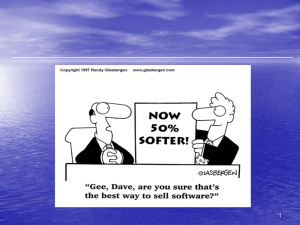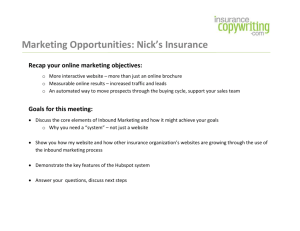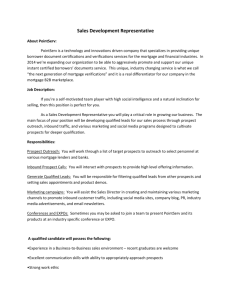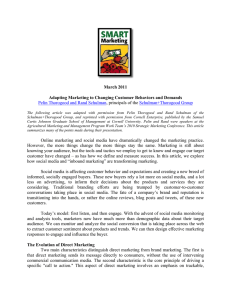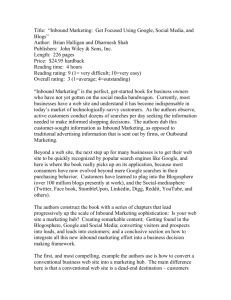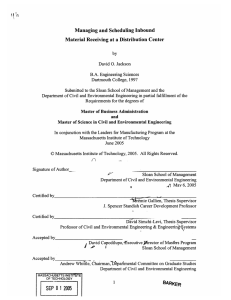5 Content Marketing Tips For Your Web Site
advertisement
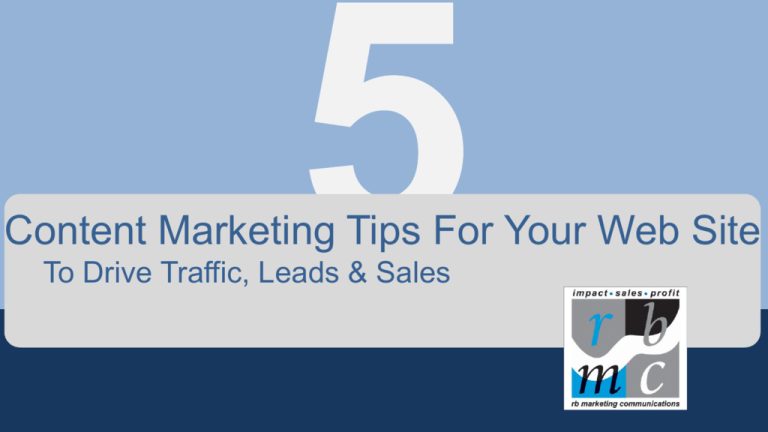
Content Marketing Tips For Your Web Site To Drive Traffic, Leads & Sales INTRODUCTION Fortunately for you, many companies still have a “masterpiece” attitude when it comes to content on their web sites. They think that once they’ve created a web site, then it’s perfect and “job’s done”. A recent survey reported that up to 65% of buyers have made their purchase decision before they even contact a salesperson. Sometimes months or years go by before a traffic analysis or a search engine optimization (SEO) review shows that too few people are visiting the site or failing to come back. Why does this happen? Somebody hasn’t been thinking like their customers. What are your customers problems and how can you as a business solve them? No, your spec sheets, company brochure and online store aren’t enough. Today’s web buyers are driving in the fast lane. They want you to tell them how to solve their problems. They want more than the specs, more than a low price, more than a rah-rah, “We’re the best”. They want a deeper engagement with you through informative, problem-solving content. Isn’t that a job for sales people? No, they’re closers. You are the marketing “opener” or they will never get the opportunity to speak with the customer. That’s the new web content marketing paradigm shift. Driving Traffic To The Sales Funnel The content on your web site plays a huge role in your customer’s purchase journey. Your web site is their point of entry in their search for a new product or service. The content you provide on your web site helps prospects move from general awareness at the top of the funnel to purchase decision readiness. Have you thought about how to move prospects through each level of readiness? Think about the types of content and calls to action that will support your buyer’s needs in terms of: • Problem solving • Credibility building • Budget availability • Purchase authority • Need and timing What Is Content Marketing? The term “content marketing” is the Internet community’s buzz term for something that you’re already doing in one form or another, such as an infographic, tech article, or case study, as well as videos, e-blasts, etc. What distinguishes effective content marketing from these other tactics is the systematic way these longer story pieces can be broken down into fast, easily digestible chunks of web content. These fast-read web chunks are then distributed through outbound web marketing channels: blogs, social media, portals, e-blasts, web pages, e-newsletters, etc. They generate inbound traffic to your web site, where strategic calls to action guide your prospect through to a successful purchase experience. Content Is King Content is one of the most important aspects of any web site. With the rise of inbound marketing, content has become front and center in the minds of marketers. It is what search engines and people are looking for. It’s what drives visitors to your site and turns prospects into leads. Take a look at these next must-haves for creating killer web site content. Strategic Messaging There are four basic questions you need to ask yourself regarding the content of your web site. • Will people know what I do within seconds? • Will they understand what page they’re on and what it’s about? • Will they know what to do next? • Why should they buy/subscribe/download from this site instead of from someone else? Ideally, you want your visitors to know the answers to these questions. It should be readily apparent what your site is about, what they can do there and why they should take action. On your homepage and most important pages, consider these helpful tips in delivering the right message: • Create a few headlines and sub-headline ideas for your most important pages. To address question #4 (why should I buy from you?) use a powerful value proposition and steer clear from generic clichés, gobbledygook terms and corporate speak. Strategic Messaging—An Example What Basecamp is Clear next steps Who is it for • Make sure to include clear calls-to-action and next steps. Include links in your body copy, next step links at the end of the copy and calls-to-action wherever appropriate. Include a little direction and you’ll be glad you did. • Test your copy. For the most accurate indication of a winning headline, use A/B testing to determine which variation drives the most conversions. Try tools like HubSpot’s A/B Testing Tools, Google’s Website Optimizer or services like 5 Second Test. • Evaluate your content. Ask customers to rate or rank content in terms of helpfulness with follow-up email surveys. Educate and Offer Value Even though the purpose of a web site is to provide information about your products and services, not everyone is ready to buy when they first hit your site. Second, remember it’s not all about you. What’s in it for them? • Offer more than just product content. Provide case studies, eBooks, whitepapers, videos and other forms of educational, helpful content. They nurture prospects through your sales funnel until they are ready to buy, plus, prospects will feel as if they are receiving valuable information along the way and not just a sales pitch. • In product-specific content, write as if you are speaking directly to your audience. Use words like “you,” and “we.” Be transparent. Make yourself sound human. Speak their language. • Write your product content as if you are helping them solve their problems. Avoid “we are the best” speak and instead use “this is how we help you….” The Importance of Quality Quality content is truly “King” and a must-have for any web site. Everyone knows lots of content is a good thing, but search engines are smarter and buyers are becoming more selective. Be sure to: • Create unique content. People love this and so do search engines. • Write for humans, not search engines. People don’t read like robots. • Provide value and educational content that helps others. • Partner with third-party content providers. Be ready to help them become subject experts about your company’s products or services. • Keep content fresh. Replace old news regularly on your site. • Know your audience. Providing content that is specific to your buyers makes it more relevant for them, and in turn, higher quality. • Include evidence. State facts, numbers, awards, testimonials, etc., try to back them up with a source and give credit when credit is due. • Know your subject well. Accurate content equals quality. Take advantage of the subject experts at your company—get them involved. Reduce Buzzwords, Jargon & Slang A professional image is necessary, but you still want to avoid the dreaded corporate gobbledygook. What is gobbledygook you ask? Great question. These are jargon terms and phrases that have been over-used, abused and rendered meaningless (you’ll find them mostly in the high-tech and B2B industry). These words are meant to add more emphasis to a particular subject, but their overuse will make your customer’s eyes roll. Keep the focus on describing the customer benefits of your: next-gen, cutting-edge, groundbreaking widget that’s smarter, more flexible, scalable and easy-to-use in those mission critical applications appropriate only for best of breed devices. Minimize the use of these words on your web site and in other materials whenever possible: • Next Generation • Cutting-edge • Flexible • Groundbreaking • Robust • Best of breed • Scalable • Mission critical • Easy to use • And so on… I think I’ve put you through enough torture. Give Treats Not Tricks The recent trend of click-baiting headlines has tricked us as marketers into thinking that salacious headlines and phrases work well at capturing our attention. That’s not the work of the reputable site developer or advertiser. “Tricks might work for a while, but they destroy your site visitor’s trust. As consumers we are tired of trickery and surreptitious persuasion. We don’t want to be gimmicked, or fooled. We just want the truth!” Wouldn’t it be easier to get to the point in our content instead of trying to persuade others? If you focus your content on being clear, not clever, you will find that more people will place their trust in you. Be careful not to make things more complicated than they need to be. Use simple words that are easy to understand. Just be clear with what you want people to do on your site. You will gain more fans and followers in the long-run. Conclusions The internet has changed everything. The strategy behind and the quality of your web site’s content is essential for inbound marketing success. It’s the nectar that attracts the customer bees. Inbound content is the hub that integrates search engine optimization (SEO) rankings, social media, blogging, landing pages and the calls-to-action that drive traffic, leads and sales. Helpful content is creating a sales paradigm shift on the web. After all it is these components that generate sales and revenue for your business. Inbound marketing is the key to filling your sales funnel with qualified leads and your web site is where education, engagement and conversion take place. Follow these guidelines and you will soon have a great web site with unique content that generates traffic, leads and sales. But don’t stop there. A web site never truly stops growing. Keep learning and stay tuned for more updates. Thanks for reading. About Us RB Marketing Communications, Inc. is a web marketing agency specializing in content marketing and inbound marketing. We serve clients in a variety of businesses: professional services, small business retail, nonprofit organizations and technology companies. We help clients connect with customers online to grow their businesses. What We Do Let us help you focus on the important web marketing strategies and tactics that drive online success. Our services include: brand development, content and inbound marketing, blogs, social media, web site design and search engine optimization, public relations, advertising and more. Who We Are With over 20-years of experience in marketing, sales, advertising, public relations and sales lead management, we are here to help you turn your web site into a revenue engine. We know the factors that drive customers to make purchase decisions and how the web influences those decisions. Get Your Free Inbound Marketing Assessment Liked what you read? Why not sign up for RBMC’s free Inbound Marketing Assessment?
